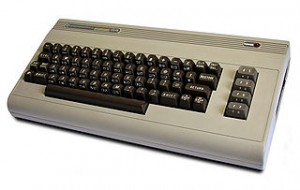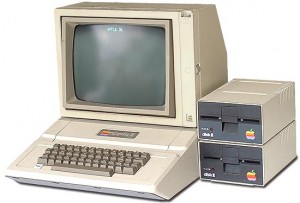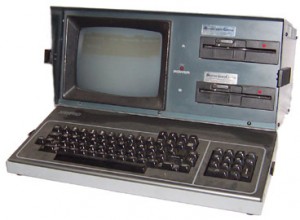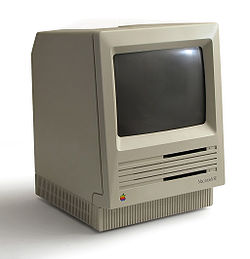The scope of ancient and antqiue computers was broader than what I owned back in the early 1980s. If you want to relive the past, then you’ll have to explore options other than the Radio Shack and IBM computers I used.
Other popular computers, er, microcomputers of the early 1980s included the Commodore, the Apple II, the Macintosh, the Sinclair, and the Kaypro.
There was also the Compaq, which was essentially a portable (suitcase-sized) IBM PC. It was pretty popular, but because it was a PC I don’t think it has the nostalgia factor of the other systems.

Commodore 64
I believe the Commodore 64 was the most popular computer system in the 1980s, probably because it was the cheapest. Therefore, you find a lot of C64s on eBay, including many complete systems. All you need is a TV set for the C64’s monitor, and you’re good to go.

Apple II+
The Apple II was the king of the microcomputers as far as I was concerned. I really, really wanted an Apple II, but couldn’t afford it. Well, I could have afforded it, but I was eager to get started and didn’t want to work another 6 months to get such a system.
I remember dreaming about owning an Apple II, specifically the Apple II Plus.
Today I could have an Apple II Plus for about $200 on eBay. It was $1200 back in the day, which didn’t include floppy drives or a monitor.
The early Macintosh was a classic. The original system was a slug, of course, with only 128K of RAM and puny 800K floppy drives. The Mac Plus was marginally better. I ended up getting a Mac SE in 1987 or so. I saw plenty of Mac SEs on eBay, ranging from $20 up to $60.

Timex-Sinclair T1000
The Sinclair was known here in the States as the Timex-Sinclair. It originally sold for $100 and got a lot of people started in computing. I see plenty of those systems on eBay for about $10 each. I never got a Sinclair because the keyboard was a membrane thingy. As someone who types a lot, I couldn’t abide by a membrane keyboard.

Kaypro 4
Finally, you’ve probably never heard of the Kayrpo. It was a local company back in San Diego, where I lived. They manufactured CP/M computers and made them portable. The Kaypro was really popular for a long time in the early 1980s. I see a Kaypro 4 on eBay for $120, which is a good price.
Eventually Kaypro started making IBM PC clones, which was their downfall; they couldn’t compete with IBM itself or Compaq. That’s the way things went back then, and why such vintage computers are rare today.
There’s a nostalgic part of me that would enjoy playing on the systems I “grew up” with, but there’s also a practical part of my brain that realizes how much more fun, useful, and speedy are today’s computers. So if you really, really want an ancient computer, and to live a digital life where 64K of RAM was consider oodles of storage, you’re welcome to try.



Couple of errors to point out here:
The Mac 128k only had 400KB floppy disks although I think a ROM upgrade was available later to get 800KB disk drives.
“Finally, you’ve probably never heard of the Kayrpo.”
Kayrpo? I don’t think I’ve ever heard of it! I’ve heard about the Kaypro but not the Kayrpo 😛
Comment by linuxlove — March 3, 2010 @ 7:57 am
HA! I seriously don’t remember the 400K drives. I suppose that’s because it was a rather short-lived thing. Weird. I remember 180K floppies, of course. It was just so exciting when they became 360K floppies! Woot!
Comment by admin — March 3, 2010 @ 8:14 am
Anyway, I live in a world where “640k should be enough for anyone.”
I’d like a different computer than the PC, maybe something like an Apple ][.
Comment by linuxlove — March 3, 2010 @ 8:16 am
The Apple II had its quirks. What helped it out was its thorough documentation. Woz was a hacker and knew what the hardware and software guys wanted in documentation. Apple provided it. So there were hardware add-ons and software galore for the Apple II.
Apple still gives away the SDK for its stuff, promoting software. But on hardware they’ve become pretty tight. That keeps the software compatible, which is a good thing. And, seriously, I don’t see as many people doing their own hardware these days. Way back when, you could buy a breadboard expansion card for your PC or Apple II and basically make your own hardware.
Comment by admin — March 3, 2010 @ 8:26 am
Dan- You should really write a book on how to run old software on an emulator of a classic computer like the C64 or DOS on a PC. Im 44 years old, but I didnt start using a PC till 98, so I think there are a lot of people like myself who would get a kick out of running an old word processor or program in basic or whatever else there was to do back then. I dont know what the legal ramifications of downloading and running old abandonware programs are though.
If I were to buy an old C64 would I have to buy floppys to run software on it or are there modern hardware connections I could make with a modern HD?
Also you forgot to mention the Atari as one of the biggies of the 80s.
Comment by BradC — March 3, 2010 @ 1:21 pm
Atari made computers in the 1980s?
Oh! See? There I go again, making fun of what I once called “toy computers.” My impression was that any “computer” that featured a game cartridge slot was not really a computer. I was wrong, of course, but I enjoyed annoying people. Still do.
You would need a floppy drive for the C64. It might have had the smarts to handle a hard drive, but not a modern one. You would need an old MFM or RLL 10MB or 20MB from the stone age of computing and then some type of adapter — if the C64 had one.
I never used a hard drive on my TRS-80 machines. They had a hard drive, a 10MB monster that was 4 inches tall and about 17 inches square. Because the TRS-80 didn’t sport a hierarchical file system, the 10MB drive was split up into 8 or so partitions, each of which had a drive letter or number. The C64 might have been the same way.
The ProDOS operating system for the Apple II had a hierarchical file system, if I remember correctly. The early Mac OS had a folder system for organizing files, but it was only one level deep.
A book on all this would be interesting, and maybe publishers would be willing to print it up. I’ll check with my agent. Thanks!
Comment by admin — March 3, 2010 @ 1:37 pm
Maybe you should do a whole book on “Computer Emulation For Dummies” which talks about computer emulators for these old computers and things like Windows Virtual PC or QEMU.
Other old computer related thoughts:
People over at The Vintage Computer Forums actually have made an 8-bit IDE card for PC/XT computers that lets you use modern IDE hard drives with old PCs. I’d get one myself but there is no power lead on the card so it won’t work with IBM PS/2 models 25 and 30, 8086 flavor.
Comment by linuxlove — March 3, 2010 @ 1:41 pm
Also, I think the Mac SE was introduced with two 800K floppy drives but later added 1.44MB floppy disks (FD/HD) and a hard drive.
Looking to get a C64? You’ll want a 1451 floppy drive, unless you love tape (who did?). No hard drive I know of has ever existed for the C64, but if they did exist I’d bet they are rare. Apparently the C64 was and still is really popular over in Europe so make sure to get a NTSC version if you’re here in the States or Canada.
Vintage Macs are fun but to me they seem useless.
Vintage PCs, you can buy boards and such for a low price (or a high price if you have some idiot who can’t price things right), because they are usually clone systems. The true big blue IBM stuff tends to bring more money than the clone systems. I paid nothing for mine though L:
Comment by linuxlove — March 3, 2010 @ 1:51 pm
Also remember the file system limitation. The PC’s FAT system could only access 10MB of storage. It was improved afterwards, but there are still limitations. So hooking up a modern hard drive to an older PC, even if the hardware runs, means you’d probably have to do lots of partitioning to use even a fraction of the storage available — not that those things need a lot of storage.
Comment by admin — March 3, 2010 @ 2:17 pm
I know a guy who has a prototype version of the same card and is running a 10GB hard drive in his XT clone just fine. I think it’s DR DOS though.
Comment by linuxlove — March 3, 2010 @ 3:21 pm